Improving Reliability Indices of the Autonomous Power System of Crete Island Utilizing Extended Photovoltaic Installations
Abstract
:1. Introduction
2. Methodology Followed
2.1. Derivation of the Expected Thermal Generation Probability Density Function (PDF)
- 10 MW for PLoad(mo,hr)
- 5 MW for PWind(mo,hr)
- 2.5 MW for PPV(mo,hr)
2.2. Reliability and Forced Outage Rate
3. The Power System of Crete
4. Results
4.1. Capacity Credit Estimation
4.2. Reliability Evaluation
5. Conclusions
Author Contributions
Funding
Conflicts of Interest
Nomenclature
| CC | Combined Cycle |
| DSM | Demand Side Management |
| EENS | Expected Energy Not Supplied |
| FOR | Forced Outage Rate |
| HEDNO | Hellenic Electricity Distribution Network Operator |
| LOLE | Loss of Load Expectation |
| LOLP | Loss of Load Probability |
| LWLOLE | Load with Loss of Load Expectation |
| ICE | Internal Combustion Engine |
| OCGT | Open Cycle Gas Turbine |
| PV | Photovoltaic |
| RES | Renewable Energy Sources |
| probability density function | |
| kWp | kiloWatt peak of photovoltaic power |
| PLoad(mo,hr) | Probability density function of load demand |
| PLoad_loss(mo,hr) | Probability density function of the load that available units cannot meet |
| PPV(mo,hr) | Probability density function of photovoltaics production |
| PTh_units(mo,hr) | Probability density function of load to be served by the thermal units |
| PWind(mo,hr) | Probability density function of wind parks production |
| T | Time period |
| fLoad(mo,hr) | Probability density function of frequency of load demand |
| fPV(mo,hr) | Probability density function of frequency of photovoltaics production |
| fTh_units(mo,hr) | Probability density function of frequency of the load to be served by thermal units |
| fWind(mo,hr) | Probability density function of frequency of wind parks production |
| pi | Probability of the unit being available |
| qi | Probability of the unit being unavailable |
References
- SolarPower Europe—Leading the Energy Transition. Available online: https://www.solarpowereurope.org/ (accessed on 17 November 2019).
- CSP Today|New Energy Update. Available online: https://analysis.newenergyupdate.com/csp-today (accessed on 8 December 2019).
- Praveen, R.P.; Abdul Baseer, M.; Awan, A.B.; Zubair, M. Performance Analysis and Optimization of a Parabolic trough Solar Power Plant in the Middle East Region. Energies 2018, 11, 741. [Google Scholar] [CrossRef] [Green Version]
- Malamatenios, C.; Vezirgianni, G.; Giakoumelos, E.; Tsikalakis, A.; Tomtsi, T.; Hatziargyriou, N. Concentrating Solar Power (CSP) Technologies and Applications in the Middle East & North Africa (MENA) Countries. Available online: http://www.oas.gr/wp-content/uploads/2010/09/Concentrating-Solar-Power-CSP-Technologies-and-Applications-in-the-Middle-East-North-Africa-MENA-Countries.pdf (accessed on 8 December 2019).
- Behar, O.; Khellaf, A.; Mohammedi, K. A review of studies on central receiver solar thermal power plants. Renew. Sustain. Energy Rev. 2013, 23, 12–39. [Google Scholar] [CrossRef]
- Evangelisti, L.; De Lieto Vollaro, R.; Asdrubali, F. Latest advances on solar thermal collectors: A comprehensive review. Renew. Sustain. Energy Rev. 2019, 114, 109318. [Google Scholar] [CrossRef]
- Rashid, K.; Safdarnejad, S.M.; Powell, K.M. Process intensification of solar thermal power using hybridization, flexible heat integration, and real-time optimization. Chem. Eng. Process.-Process Intensif. 2019, 139, 155–171. [Google Scholar] [CrossRef] [Green Version]
- Rashid, K.; Ellingwood, K.; Safdarnejad, S.M.; Powell, K.M. Designing Flexibility into a Hybrid Solar Thermal Power Plant by Real-Time, Adaptive Heat Integration. Comput. Aided Chem. Eng. 2019, 47, 457–462. [Google Scholar] [CrossRef]
- Brellas, K.; Tsikalakis, A.; Kalaitzakis, K. Reducing Solar Dish Park Production Volatility Utilizing Lithium-ion Batteries. Period. Polytech. Electr. Eng. Comput. Sci. 2016, 60, 254–260. [Google Scholar] [CrossRef] [Green Version]
- Chowdhury, B.H.; Sawab, A.W. Evaluating the value of distributed photovoltaic generations in radial distribution systems. IEEE Trans. Energy Convers. 1996, 11, 595–600. [Google Scholar] [CrossRef]
- Haas, R. The value of photovoltaic electricity for society. Sol. Energy 1995, 54, 25–31. [Google Scholar] [CrossRef]
- Gil, H.A.; Joos, G. On the quantification of the network capacity deferral value of distributed generation. IEEE Trans. Power Syst. 2006, 21, 1592–1599. [Google Scholar] [CrossRef]
- Hoff, T.; Shugar, D.S. The Value of Grid-Support Photovoltaics to Substation Transformers. Available online: https://www.cleanpower.com/wp-content/uploads/2012/02/047_ValuePVTransformerSupport.pdf (accessed on 17 November 2019).
- Tsikalakis, A.G.; Tzouliadaki, T. Chapter 9. Electrification of Rural Areas using Renewable Energy Sources: Review of Best Practices around the World. In Renewable Energy: Economics, Emerging Technologies and Global Practices; Poulikkas, A., Ed.; Nova Publishers: Hauppauge, NY, USA, 2013; pp. 197–246. [Google Scholar]
- Lallement, D.M.; Terrado, E.N.; Zhang, Y. Empowering information and communication technologies in isolated areas: Learning from the solar-net villages program in honduras. Renew. Sustain. Energy Rev. 2006, 10, 46–53. [Google Scholar] [CrossRef]
- Labed, S. PV Large Scale Rural Electrification Programs and the Development of Desert Regions. In Sustainable Energy Production and Consumption; Barbir, F., Ulgiati, S., Eds.; Springer: Dordrecht, The Netherlands, 2008; pp. 281–292. [Google Scholar] [CrossRef]
- Watt, M.E.; Oliphant, M.; Outhred, H.; Collins, R. Using PV to Meet Peak Summer Electricity Loads. Available online: http://www.ceem.unsw.edu.au/sites/default/files/uploads/publications/Watt%20-%20PV%20Peak%20Load%20-%20Solar%202003.pdf (accessed on 6 December 2019).
- Jurasz, J.; Campana, P.E. The potential of photovoltaic systems to reduce energy costs for office buildings in time-dependent and peak-load-dependent tariffs. Sustain. Cities Soc. 2019, 44, 871–879. [Google Scholar] [CrossRef]
- Braun, P.; Rüther, R. The role of grid-connected, building-integrated photovoltaic generation in commercial building energy and power loads in a warm and sunny climate. Energy Convers. Manag. 2010, 51, 2457–2466. [Google Scholar] [CrossRef]
- Sadineni, S.B.; Atallah, F.; Boehm, R.F. Impact of roof integrated PV orientation on the residential electricity peak demand. Appl. Energy 2012, 92, 204–210. [Google Scholar] [CrossRef]
- HEDNO. Available online: https://www.deddie.gr/en (accessed on 6 December 2019).
- Tsikalakis, A.; Hatziargyriou, N.; Karapidakis, E.; Kymakis, E. Economic Evaluation of Low Photovoltaics (PV) Penetration in Island Power Systems, application to Crete. In Proceedings of the DEMSEE, Conference on the Deregulated Electricity Market issues in South-Eastern Europe Sitia, Crete, Greece, 23–24 September 2010. [Google Scholar]
- Poulikkas, A.; Tsikalakis, A.; Hatziargyriou, N. Economic evaluation of low Photovoltaics (PV) penetration in island power systems, application to Cyprus. In Proceedings of the DISTRES, Conference on the promotion of Distributed Renewable Energy Sources in the Mediterranean Region, Nicosia, Cyprus, 11–12 December 2009. [Google Scholar]
- REBUS|Interreg Europe. Available online: https://www.interregeurope.eu/rebus/ (accessed on 27 November 2019).
- Gusmao, A.; Groissböck, M. Capacity value of photovoltaic and wind power plants in an isolated Mini-grid in the Kingdom of Saudi Arabia. In Proceedings of the Saudi Arabia Smart Grid (SASG), Jeddah, Saudi Arabia, 7–9 December 2015; pp. 1–8. [Google Scholar] [CrossRef]
- Ensslin, C.; Milligan, M.; Holttinen, H.; O’Malley, M.; Keane, A. Current methods to calculate capacity credit of wind power, IEA collaboration. In Proceedings of the IEEE Power and Energy Society General Meeting-Conversion and Delivery of Electrical Energy in the 21st Century, Pittsburgh, PA, USA, 20–24 July 2008; pp. 1–3. [Google Scholar] [CrossRef]
- Narimani, M.R.; Nauert, P.J.; Joo, J.-Y.; Crow, M.L. Reliability assesment of power system at the presence of demand side management. In Proceedings of the IEEE Power and Energy Conference at Illinois (PECI), Urbana, IL, USA, 19–20 February 2016; pp. 1–5. [Google Scholar] [CrossRef]
- Jabir, H.J.; Teh, J.; Ishak, D.; Abunima, H. Impact of Demand-Side Management on the Reliability of Generation Systems. Energies 2018, 11, 2155. [Google Scholar] [CrossRef] [Green Version]
- Tsikalakis, A.G.; Hatziargyriou, N.D.; Katsigiannis, Y.A.; Georgilakis, P.S. Impact of wind power forecasting error bias on the economic operation of autonomous power systems. Wind Energy 2009, 12, 315–331. [Google Scholar] [CrossRef] [Green Version]
- Katsigiannis, Y.A.; Karapidakis, E.S.; Tsikalakis, A.G.; Katsamaki, A. Large-scale energy storage and dynamic performance of the autonomous power system in Crete Island: A review of the literature. Int. J. Energy 2014, 8, 60–70. [Google Scholar]
- Singh, C.; Jirutitijaroen, P.; Mitra, J. Electric Power Grid Reliability Evaluation: Models and Methods; John Wiley & Sons: Hoboken, NJ, USA, 2018; ISBN 978-1-119-48627-5. [Google Scholar]
- Billinton, R.; Allan, R.N. Reliability Assessment of Large Electric Power Systems; Springer Science & Business Media: Berlin, Germany, 2012; ISBN 978-1-4613-1689-3. [Google Scholar] [CrossRef]
- Brown, R.E. Electric Power Distribution Reliability; CRC Press: Boca Raton, FL, USA, 2017; ISBN 978-0-8493-7568-2. [Google Scholar]
- Population and Social Conditions—ELSTAT. Available online: https://www.statistics.gr/en/statistics/pop (accessed on 17 November 2019).
- Tsikalakis, A.G.; Katsigiannis, Y.A.; Karapidakis, E.S.; Fiorentzis, K.E. Evaluating the effect of wind-hydro hybrid power stations on the operation of Cretan power system. In Proceedings of the 2017 52nd International Universities Power Engineering Conference (UPEC), Heraklion, Greece, 28–31 August 2017; pp. 1–6. [Google Scholar] [CrossRef]
- Stefanakis, J. Crete: An ideal study case for increased wind power penetration in medium sized autonomous power systems. In Proceedings of the IEEE Power Engineering Society Winter Meeting, Conference Proceedings (Cat. No.02CH37309), New York, NY, USA, 27–31 January 2002; Volume 1, pp. 329–334. [Google Scholar] [CrossRef]
- Gigantidou, A. Renewable energy sources in Crete. In Proceedings of the IREP Symposium Bulk Power System Dynamics and Control—IX Optimization, Security and Control of the Emerging Power Grid, Rethymnon, Crete, Greece, 25–30 August 2013; pp. 1–3. [Google Scholar] [CrossRef]
- Tsikalakis, A.; Thalassinakis, E.; Pylarinos, D. Estimation of Hosting Electric Vehicles Capacity in the Transformers on the Island of Crete. In Engineering and Industry; Trivent Publishing: Budapest, Hungary, 2016; Volume 3, ISBN 978-615-80340-7-4. [Google Scholar] [CrossRef]
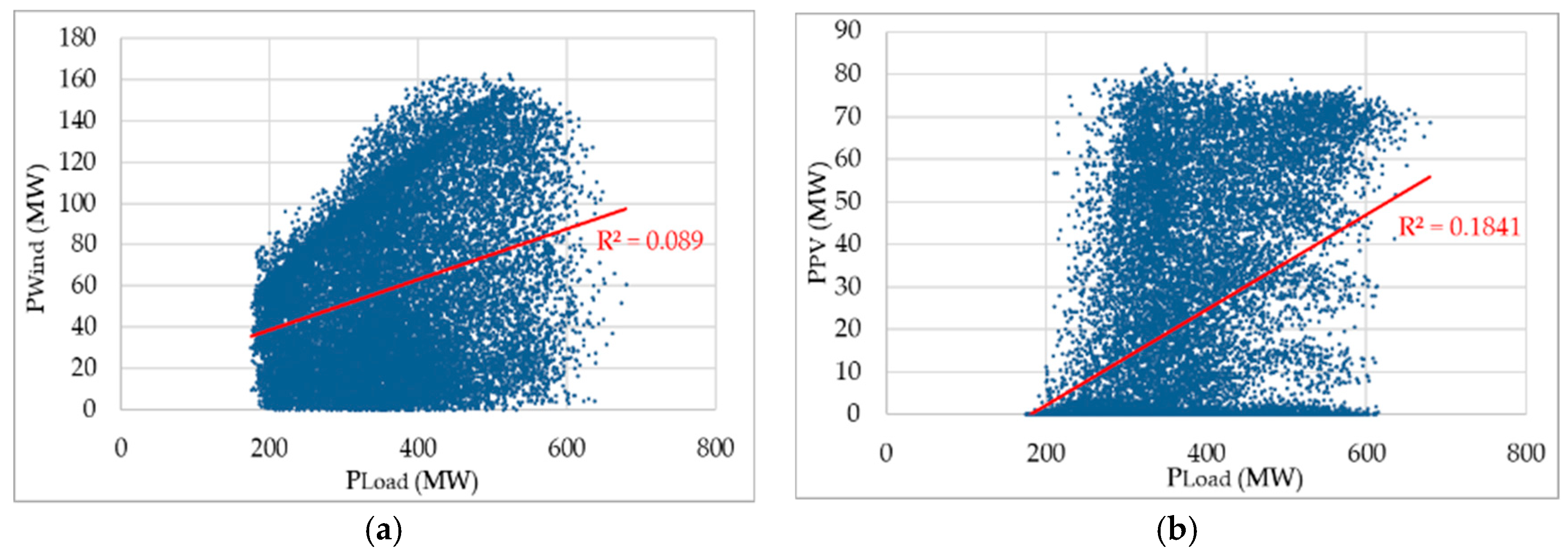

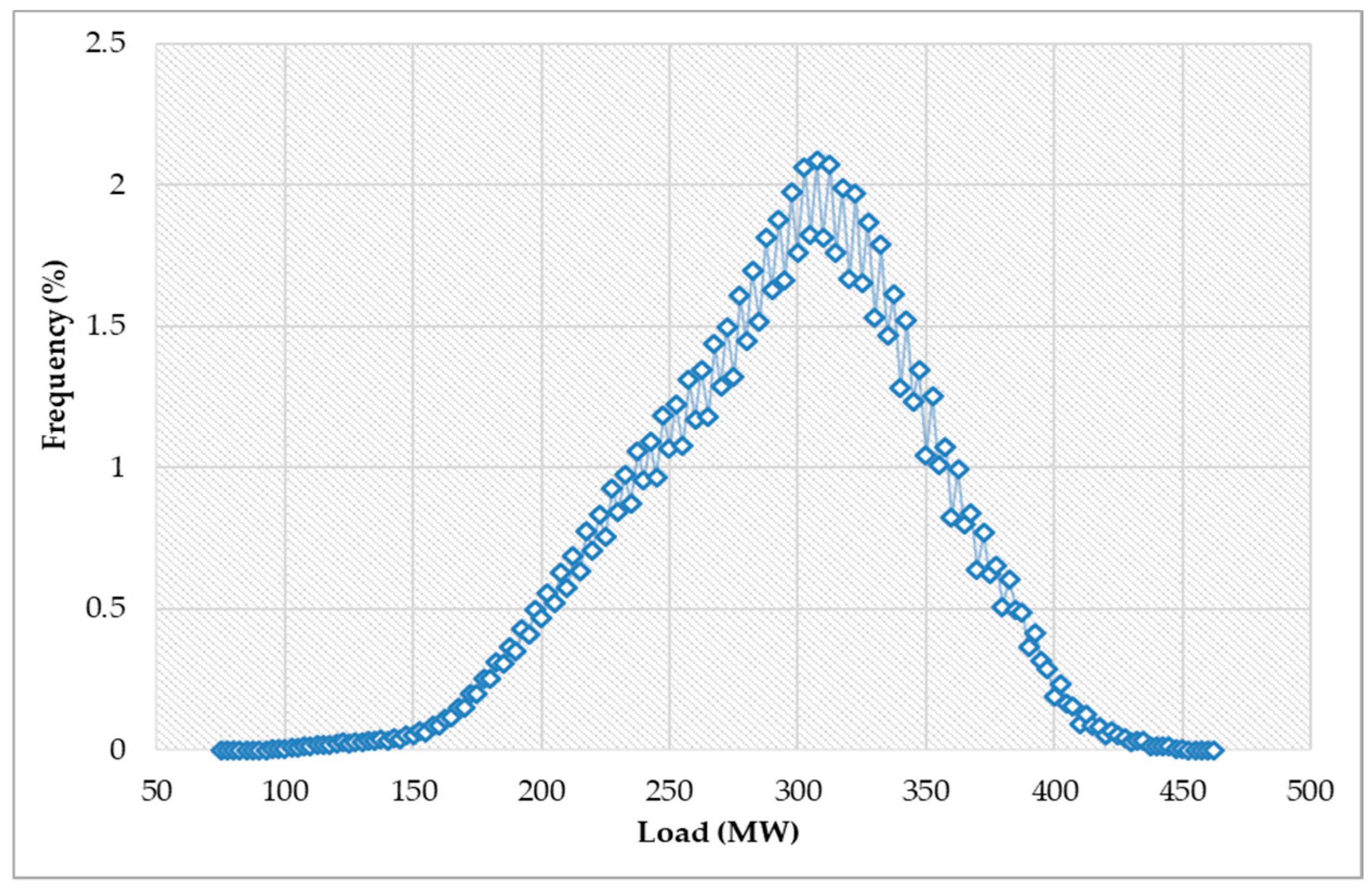

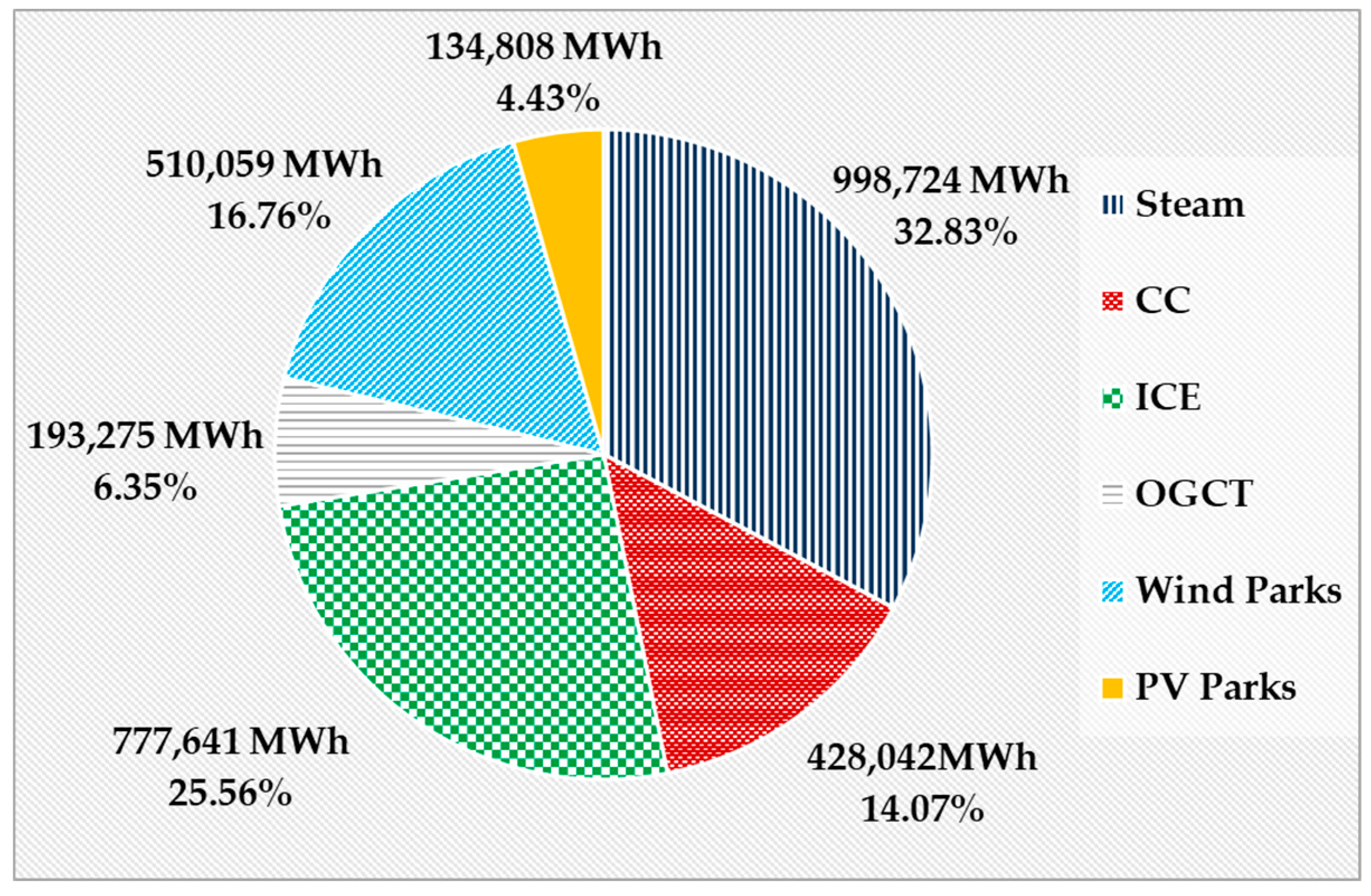


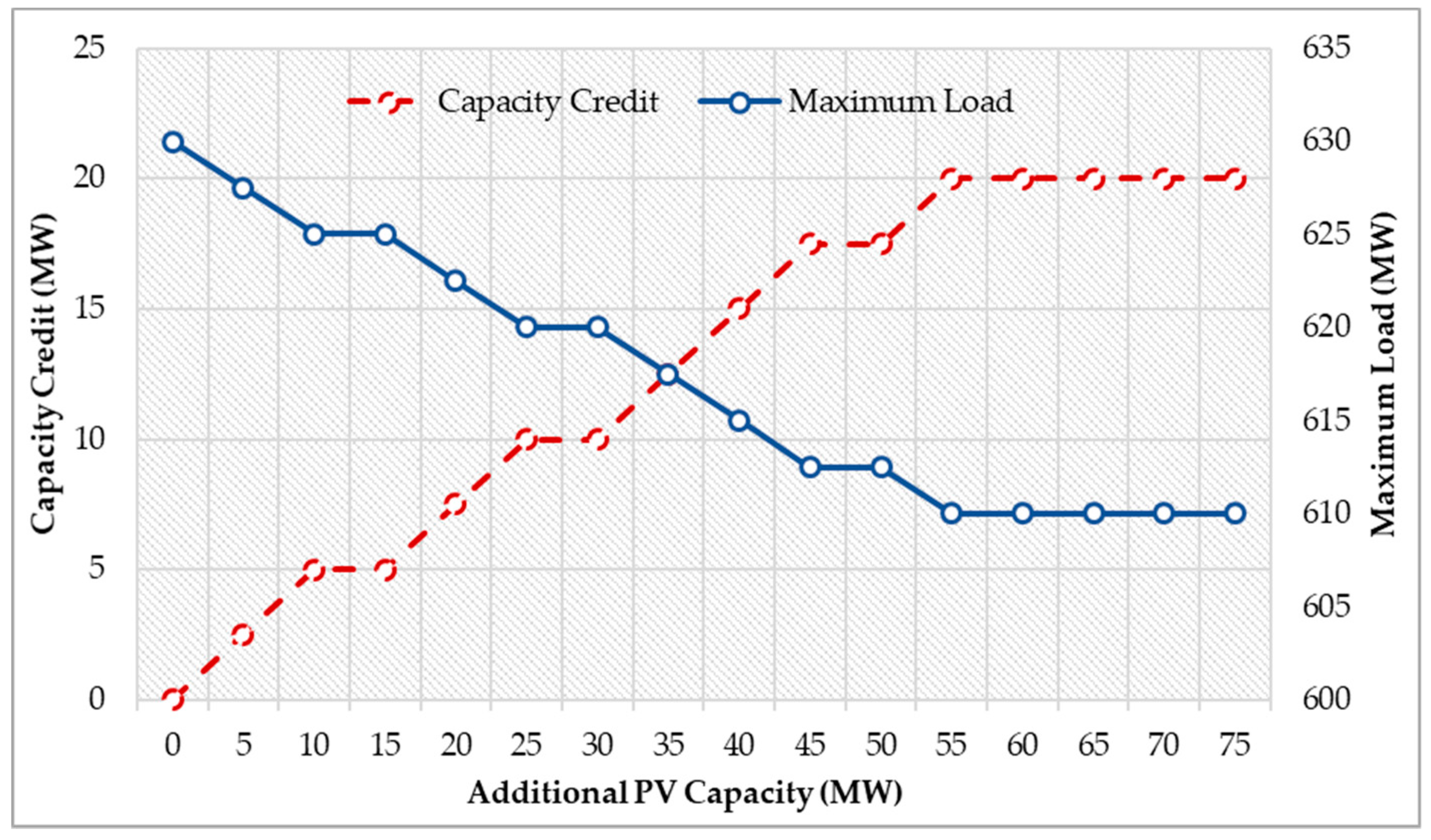



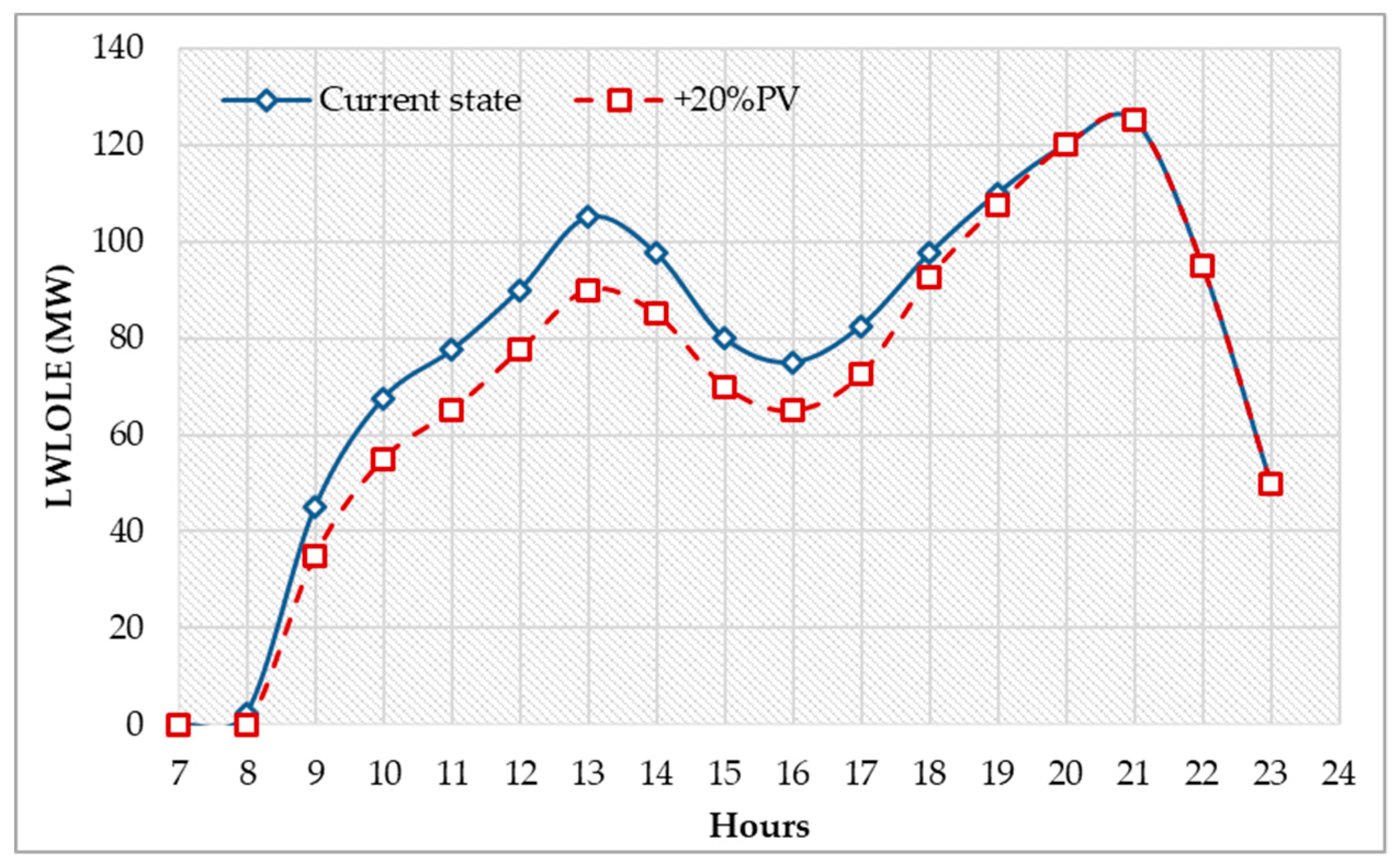

| Power Station | Steam | ICE | OCGT | CC | Total |
|---|---|---|---|---|---|
| Linoperamata | 111.3 | 49.2 | 118.6 | - | 279.1 |
| Xylokamara | - | - | 202.2 | 132.3 | 334.5 |
| Atherinolakos | 93 | 118.2 | - | - | 211.2 |
| Total capacity | 204.3 | 167.4 | 320.8 | 132.3 | 824.8 |
| Months | Current State | +20% PV | Hour |
|---|---|---|---|
| June | 610 | 610 | 20:00–22:00 |
| July | 630 | 622.5 | 14:00–15:00 |
| August | 610 | 602.5 | 13:00–14:00 |
| Months | Max LOLE (s) | Hour |
|---|---|---|
| February | 16.65 | 19:00–20:00 |
| June | 47.21 | 21:00–22:00 |
| July | 90.04 | 21:00–22:00 |
| August | 88.40 | 20:00–21:00 |
| November | 99.25 | 18:00–19:00 |
| Months | Max LWLOLE (MW) | Hour |
|---|---|---|
| February | 90 | 19:00–20:00 |
| June | 115 | 20:00–22:00 |
| July | 125 | 21:00–22:00 |
| August | 125 | 20:00–21:00 |
| November | 110 | 18:00–19:00 |
© 2019 by the authors. Licensee MDPI, Basel, Switzerland. This article is an open access article distributed under the terms and conditions of the Creative Commons Attribution (CC BY) license (http://creativecommons.org/licenses/by/4.0/).
Share and Cite
Fiorentzis, K.; Tsikalakis, A.; Karapidakis, E.; Katsigiannis, Y.; Stavrakakis, G. Improving Reliability Indices of the Autonomous Power System of Crete Island Utilizing Extended Photovoltaic Installations. Energies 2020, 13, 64. https://doi.org/10.3390/en13010064
Fiorentzis K, Tsikalakis A, Karapidakis E, Katsigiannis Y, Stavrakakis G. Improving Reliability Indices of the Autonomous Power System of Crete Island Utilizing Extended Photovoltaic Installations. Energies. 2020; 13(1):64. https://doi.org/10.3390/en13010064
Chicago/Turabian StyleFiorentzis, Konstantinos, Antonios Tsikalakis, Emmanuel Karapidakis, Yiannis Katsigiannis, and George Stavrakakis. 2020. "Improving Reliability Indices of the Autonomous Power System of Crete Island Utilizing Extended Photovoltaic Installations" Energies 13, no. 1: 64. https://doi.org/10.3390/en13010064






